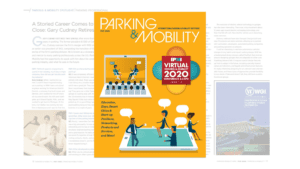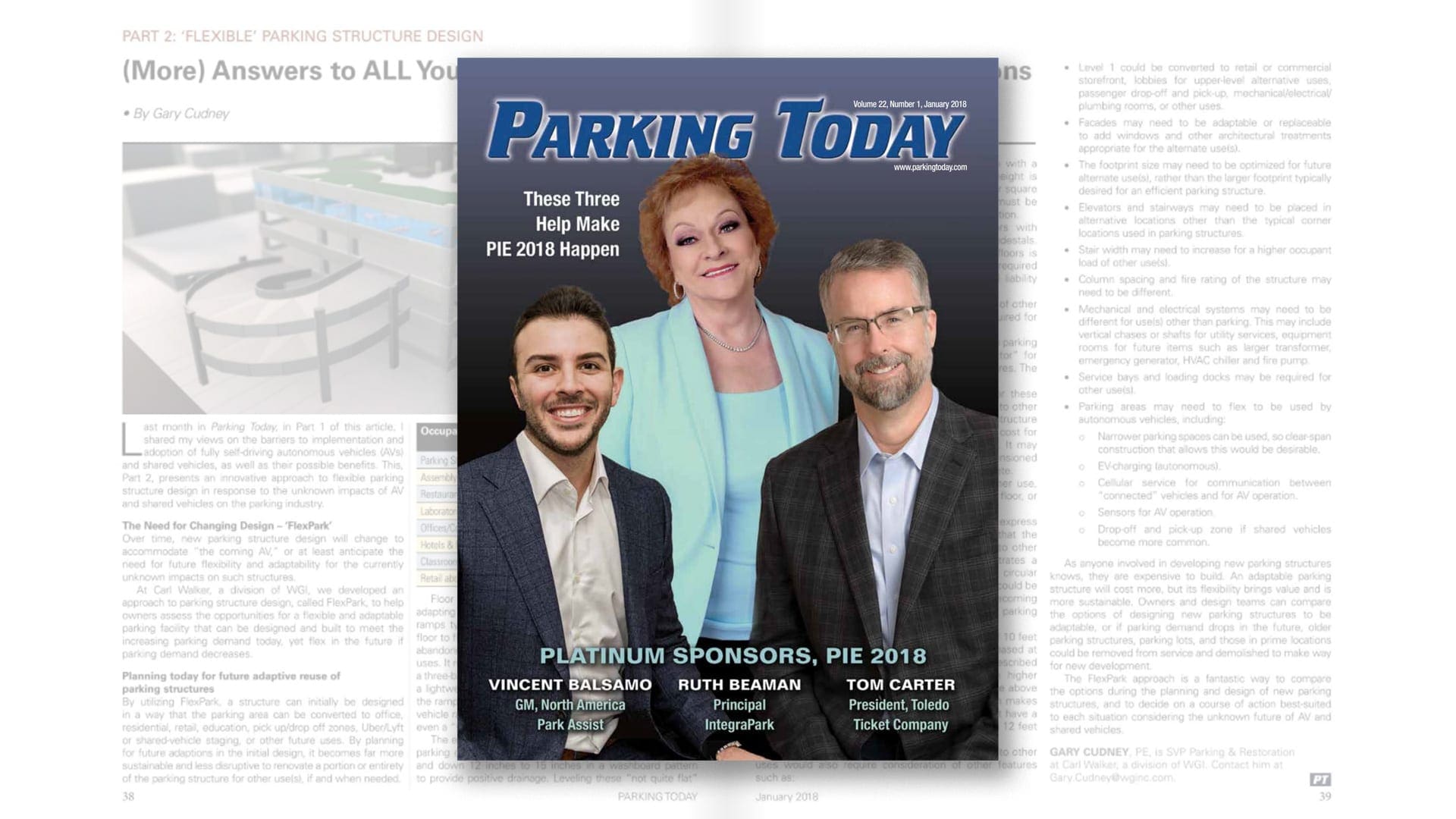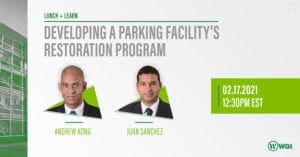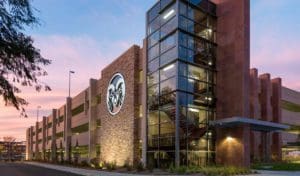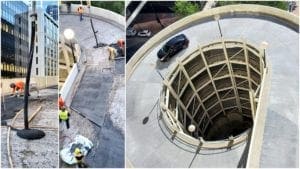This article appeared in the January 2018 issue of Parking Today. Click here to view the article.
by Gary Cudney, PE
Last month in Parking Today, in Part 1 of this article, I shared my views on the barriers to implementation and adoption of fully self-driving autonomous vehicles (AVs) and shared vehicles, as well as their possible benefits. This, Part 2, presents an innovative approach to flexible parking structure design in response to the unknown impacts of AV and shared vehicles on the parking industry.
The Need for Changing Design – ‘FlexPark’
Over time, new parking structure design will change to accommodate “the coming AV,” or at least anticipate the need for future flexibility and adaptability for the currently unknown impacts on such structures.
At Carl Walker, a division of WGI, we developed an approach to parking structure design, called FlexPark, to help owners assess the opportunities for a flexible and adaptable parking facility that can be designed and built to meet the increasing parking demand today, yet flex in the future if parking demand decreases.
Planning today for future adaptive reuse of parking structures
By utilizing FlexPark, a structure can initially be designed in a way that the parking area can be converted to office, residential, retail, education, pick up/drop off zones, Uber/Lyft or shared-vehicle staging, or other future uses. By planning for future adaptions in the initial design, it becomes far more sustainable and less disruptive to renovate a portion or entirety of the parking structure for other use(s), if and when needed.
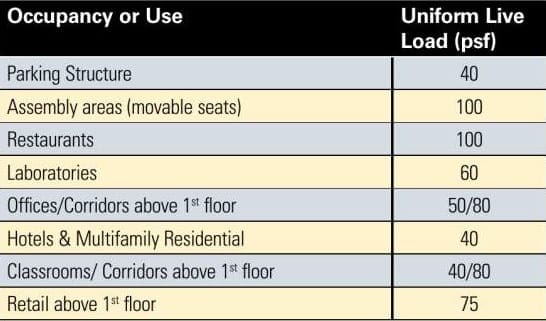
Floor slopes are the most challenging consideration in adapting a parking structure for other use. Parked-on vehicle ramps typically slope 4% to 6% for vehicular access from floor to floor. Sloping ramps of this grade would likely require abandonment and/or removal at floors converted to other uses. It may be preferred to locate the ramp at the exterior of a three-bay (or wider) parking facility or if located at the interior, a lightwell/courtyard could be created if it were removed. If the ramp is removed, the remainder of the floor that is not a vehicle ramp could be repurposed for another use; however, even a “flat” floor slopes 1.5% to 2% for drainage.
The entire “flat” bay (62-foot-wide bay with perpendicular parking on each side and a two-way drive aisle) slopes up and down 12 inches to 15 inches in a washboard pattern to provide positive drainage. Leveling these “not quite flat” floors can be done using tapered, rigid insulation with a 4-inch-thick concrete topping if additional story height is provided. The topping weighs nearly 50 pounds per square foot (psf); therefore, the parking structure floor must be designed for this heavier dead load to be a valid option.
Another option would be to level the floors with an access floor system using variable height pedestals. Building new parking structures with totally flat floors is not recommended, as they won’t provide the code-required drainage and would create significant slip-and-fall liability risk for garage owners and designers.
In addition to the higher dead load, the live load of other uses would typically be higher than the 40 psf required for parking, as shown in Table 1.
Furthermore, the lateral loads for uses other than parking could be higher, as the “seismic importance factor” for occupied buildings is higher than for parking structures. The structure must be stouter to resist these loads.
An existing parking structure, not designed for these higher loads, could not be economically converted to other uses above the first floor. Designing a new parking structure for these higher loads would add significant initial cost for larger foundations and the stouter superstructure. It may then be less expensive to use a cast-in-place post-tensioned concrete superstructure, rather than precast concrete.
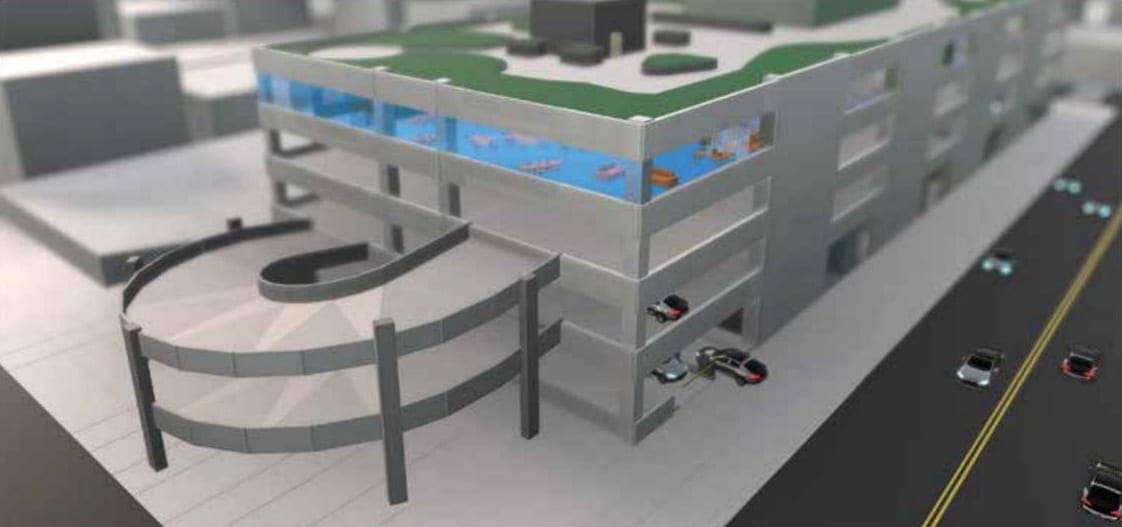
Rather than converting an entire floor to another use, the alternative option is to convert only a part of a floor, or convert the end of a longer parking structure.
Another option for future flexibility is to use express ramps, rather than sloped parked-on ramps, so that the “flat” parking floors can be more easily adapted to other uses in the future. The picture at the left illustrates a parking structure with “flat” floors accessed by a circular express ramp. As an alternative, the parking levels could be repurposed with the roof top parking at Level 5 becoming a green roof and Level 4 becoming office space if parking demand decreased in the future.
Parking structures typically have story heights of 10 feet to 11 feet, 4 inches. This would need to be increased at least 16 inches to 19 inches to level the floor as described above. Other uses would typically require even higher ceiling heights, and possibly mechanical duct space above the ceiling, so planning for this in the initial design makes sense. Level 1 of a flexible parking structure might have a story height of 14 feet to 18 feet, and upper levels 12 feet to 14 feet for these purposes.
Providing the future flexibility to retrofit parking to other uses would also require consideration of other features such as:
- Level 1 could be converted to retail or commercial storefront, lobbies for upper-level alternative uses, passenger drop-off and pick-up, mechanical/electrical/plumbing rooms, or other uses.
- Facades may need to be adaptable or replaceable to add windows and other architectural treatments appropriate for the alternate use(s).
- The footprint size may need to be optimized for future alternate use(s), rather than the larger footprint typically desired for an efficient parking structure.
- Elevators and stairways may need to be placed in alternative locations other than the typical corner locations used in parking structures.
- Stair width may need to increase for a higher occupant load of other use(s).
- Column spacing and fire rating of the structure may need to be different.
- Mechanical and electrical systems may need to be different for use(s) other than parking. This may include vertical chases or shafts for utility services, equipment rooms for future items such as larger transformer, emergency generator, HVAC chiller and fire pump.
- Service bays and loading docks may be required for other use(s).
- Parking areas may need to flex to be used by autonomous vehicles, including:
- Narrower parking spaces can be used, so clear-span construction that allows this would be desirable.
- EV-charging (autonomous).
- Cellular service for communication between “connected” vehicles and for AV operation.
- Sensors for AV operation.
- Drop-off and pick-up zone if shared vehicles become more common.
As anyone involved in developing new parking structures knows, they are expensive to build. An adaptable parking structure will cost more, but its flexibility brings value and is more sustainable. Owners and design teams can compare the options of designing new parking structures to be adaptable, or if parking demand drops in the future, older parking structures, parking lots, and those in prime locations could be removed from service and demolished to make way for new development.
The FlexPark approach is a fantastic way to compare the options during the planning and design of new parking structures, and to decide on a course of action best-suited to each situation considering the unknown future of AV and shared vehicles.
